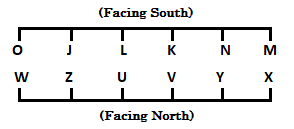I. Study the following information carefully to answer the given questions.
Twelve people are sitting in two parallel rows containing six people each in such a way that there is an equal distance between adjacent persons. In Row -1 – J, K, L, M, N and O are seated(but not necessarily in the same order) and all of them are facing south. In Row 2 – U, V, W, X, Y and Z are seated (but not necessarily in the same order) and all of them are facing North. Therefore in the given seating arrangement, each member seated in a row faces another member of the other row.
M sits fourth to the left of J. The one facing J sits third to the left of Y.
Only one person sits between Y and U. U does not sit at any of the extreme ends of the line.
Only two people sit between K and O.
The one facing Z sits second to the right of K. Z does not sit at any of the extreme ends of the line.
The one facing K sits second to the left of X.
V is not an immediate neighbour of Z. L is not immediate neighbour of M.
[expand title=”Explanation”]

[/expand]
1. Which of the following groups of people represents the people sitting at extreme ends of both the rows?
A. M, O, X, W
B. M, K, V, W
C. N, K, V, Y
D. J, N, U, V
E. J, O, Z, X
2.Which of the following is true regarding N?
A. K sits second to the right of N.
B. V is an immediate neighbour of the person who faces N
C. Both L and O are immediate neighbours of N.
D. Only one person sits between N and J.
E. None of the given options are true.
3. Who amongst the following sits second to the right of the person who faces L?
A. V
B. Z
C. W
D. U
E. Y
4. Who amongst the following faces V?
A. M
B. L
C. J
D. N
E. K
5. Which of the following is true with respect to the given information?
A. K faces one of the immediate neighbours of X.
B. V sits exactly between W and U.
C. None of the given options is true.
D. J is an immediate neighbour of K.
E. J faces Z.
[expand title=”Answers”]
1. A. M, O, X, W
2. B. V is an immediate neighbour of the person who faces N
3. E. Y
4. E. K
5. E. J faces Z.
[/expand]